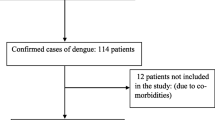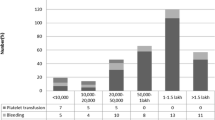Abstract
Objective
To study the clinicohematological profile and the platelet trends in children presenting with dengue infection during the 2010 dengue epidemic in north India and to compare the it with previous epidemics.
Methods
This retrospective study was carried out in a tertiary care hospital of North India. Of the 219 children admitted from August 2010 through November 2010 with suspected dengue infection, 135 were IgM positive and were included in the final analysis.
Results
These children were further categorized as dengue fever (8%), dengue hemorrhagic fever (51%) and dengue shock syndrome (42%). The mean age (± SD) of children were 8.3 ± 3.5 y with male: female ratio 1.32. Mean duration of fever (±SD) was 6.3 d ± 3.7 d. The clinical features included fever (100%), headache (63%), abdominal pain (71%), petechia (35.5%), rash (26.6%) and bleeding manifestations (48.8%). On examination, Hess test (33.3%), signs of fluid retention (23%), pallor (13.3%),signs of circulatory failure (43%), hepatomegaly (31.1%) and splenomegaly (27%) were positive. Laboratory investigations revealed mean (±SD) hemoglobin 11.5 g/dl (±1.7), hematocrit 36.1(±5.5), leucocyte count 7,551/mm3 and platelet count 38,800 mm3 on day of admission. A total of 92.6% of children had thrombocytopenia and 19.2% had abnormal leucocyte count. Deranged liver function tests were observed in 48 children. The mean (±SD) of hospitalization and platelet recovery were 4.2 ± 2.3 d and 3.6 ± 1.3 d respectively and did not vary according to disease category (P > 0.05). Bleeding manifestations were not related to platelet count (P > 0.05). There was no statistical difference in the demographic, clinical or laboratory observations according to disease category (P > 0.05). A total of 24 children had evidence of other co-infections and four had atypical complications. Dengue 2 virus was the strain reported in most of the cases.
Conclusions
This study showed shift to higher age of presentation, more number of dengue hemorrhagic fever and associated co-infections in children. The complications and mortality was low and platelet recovery time was not influenced by disease category.

Similar content being viewed by others
References
Aikat BK, Konar NR, Banerjee G. Haemorrhagic fever in Calcutta area. Indian J Med Res. 1964;52:660–5.
Aggarwal A, Chandra J, Aneja S, Patwari AK, Dutta AK. An epidemic of dengue haemorrhagic fever and dengue shock syndrome in children in Delhi. Indian Pediatr. 1998;35:727–32.
Narayanan M, Aravind MA, Thilothammal N, Prema R, Rex CS, Sargunam Ramamurty N. Dengue fever epidemic in Chennai—a study of clinical profile and outcome. Indian Pediatr. 2002;39:1027–33.
Ratageri VH, Shepur TA, Wari PK, Chavan SC, Mujahid IB, Yergolkar PN. Clinical profile and outcome of dengue fever cases. Indian J Pediatr. 2005;72:705–6.
Banerjee M, Chatterjee T, Choudhary GS, Srinivas V, Kataria VK. Dengue: a clinicohaematological profile. MJAFI. 2008;64:333–6.
Batra P, Saha A, Chaturvedi P, Vilhekar KY, Mehindiratta DK. Outbreak of dengue infection in Rural Maharashtra. Indian J Pediatr. 2007;74:794–5.
Guidelines on Clinical Management of Dengue Fever and Dengue Haemorrhagic Fever. Government of India. Directorate of National Vector Borne Diseases Control Programme. Directorate General of Health Services, Ministry of Health and Family Welfare. National Vector Borne Disease Control Programme (NVBDCP).
Schexneider KI, Reedy EA. Thrombocytopenia in dengue fever. Curr Hematol Rep. 2005;4:145–8.
Chuansumrit A, Tangnararatchakit K. Pathophysiology and management of dengue hemorrhagic fever. Transfus Altern Transfus Med. 2006;8:3–11.
Gomber S, Ramachandran VG, Kumar S, et al. Haematological observations as diagnostic markers in DHF-A reappraisal. Indian Pediatr. 2001;38:477–81.
Chandrakanta, Kumar R, Garima, Agarwal J, Jain A, Nagar R. Changing clinical manifestations of dengue infection in North India. Dengue Bull. 2008;32:118–25.
Gupta E, Dar L, Kapoor G, Broor S. The changing epidemiology of dengue in Delhi. India Virology J. 2006;3:92.
Garg P. Utility of clinical improvement and platelet count recovery time in counseling children hospitalized with suspected dengue in a resource-poor setting. JCDR. 2008;61:149–54.
Contributions
MMAF, HM: Conceptualized the study; HM, SK, RP: Collection of data, analysis and drafting of the manuscript; MMAF: Critical reviewer for the manuscript; HM :Guarantor for the study.
Conflict Interest
None.
Role of Funding Source
None.
Author information
Authors and Affiliations
Corresponding author
Rights and permissions
About this article
Cite this article
Mittal, H., Faridi, M.M.A., Arora, S.K. et al. Clinicohematological Profile and Platelet Trends in Children with Dengue During 2010 Epidemic in North India. Indian J Pediatr 79, 467–471 (2012). https://doi.org/10.1007/s12098-011-0586-7
Received:
Accepted:
Published:
Issue Date:
DOI: https://doi.org/10.1007/s12098-011-0586-7




